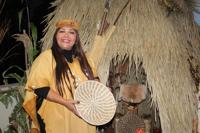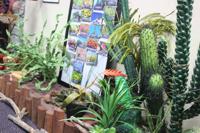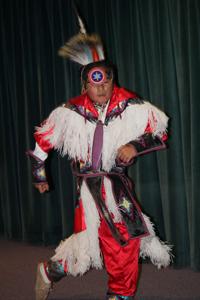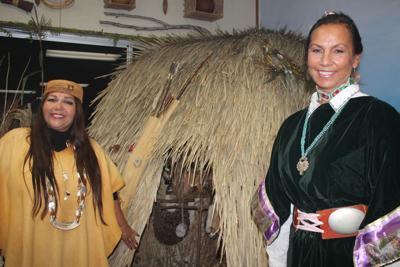Native american museum at SC school adds second building

Jacque Nuñez of the Juaneño Band of Mission Indians in front of the kiicha display at the new Earth Lodge at Clarence Lobo Elementary School in San Clemente. The lodge explains the science behind water and includes a Native American perspective. Photo by Jim Shilander
By Jim Shilander
Tucked behind a San Clemente elementary school named for an Acjachemen leader now sits a pair of unique portable classrooms housing a Native American Museum.
Since its return three years ago, Clarence Lobo Elementary School’s Lobo Lodge has allowed students in the Capistrano Unified School District the opportunity to examine the history of native and indigenous peoples across the country and in south Orange County. Led by a dedicated group of staff and volunteer docents, a second building, the Earth Lodge, has recently been added. The new addition will afford students the opportunity to explore, from both traditional western scientific and native perspectives, their own impact on local watersheds.
Staff members believe the lodges may be the only museums located on the grounds of an elementary school dedicated to the study of native cultures and peoples.

Desert plants illustrate the importance of water in different parts of the ecosystem at the Earth Lodge. Photo by Jim Shilander
Members of the Lobo school family, as well as educators and members of area tribes, celebrated the opening of the school’s Earth Lodge Monday, with tribal dances and words of thanks to those who helped make the museum possible.
The effort to bring the Earth Lodge to Lobo began two years ago, when the Children’s Museum at La Habra was breaking down an exhibit on the science of water.
Jacque Nuñez, a storyteller and member of the Juaneño Band of Mission Indians, was got her hands on the display. With an exhibit in hand, volunteers pieced together the new lodge and, in the words of docent Dina Gilio-Whitaker, worked to “indigenize” the exhibit.
At that time, Nuñez worked as a storyteller at the museum. When employees there asked her to take look at the display, she was impressed, and she said she knew she wanted to do something with it. She thought of using the display for her and her husband’s company, Tamaayowut, which supplies renewable energy sources to reservations. Nuñez looked at creating a mobile education program, but ultimately decided it was unfeasible.
“After that, I decided I would do anything I could to buy it from them,” Nuñez said. “So I bartered with them, the old Indian way.”
In exchange for telling a number of stories at the museum, Nuñez was able to ensure the display would be used for public education and outreach.
“I hope it opens students’ eyes to know they can make a difference,” Nuñez said.
The real work however, soon began, as volunteers from the community took two years to reassemble the exhibit with the addition of artifacts, photographs and displays to illustrate the native perspective. This was done, Whitaker said, with only $1,000 in district funding, through a grant from the CUSD Foundation.
Whitaker said the new museum will provide insight into the native-American perspective on water. The exhibit includes information about how watersheds transport water from mountains down to the ocean, as well as the way water effects different types of ecosystems. Additions to the exhibit include a native home, the kiicha, to illustrate the way indigenous peoples made their homes near water and how they balanced their own needs with sustaining the waters.
“There’s a whole different way of seeing the relationship to water,” Whitaker said. In recent years, she noted, western science had come to look more favorably on the understandings of native people had for water. Specifically, she said, this meant that rather than viewing resources like water only in terms of what could be extracted, it meant also understanding that humans are part of whatever ecosystems they inhabit.
“The challenges we face demand nothing less than the best of all cultures working together,” Whitaker said. Not only are people to act as caretakers of the land, they also needed to understand they were part of it.
First-year Lobo principal Cheryl Sampson said students at the school were “Very much a part” of the lodge, with students learning songs and dances, along with being able to tour the facility to provide real illustrations on lessons about native cultures. Having the new Earth Lodge on campus only enhances those educational efforts, she said.

Dancer Ba’ac Garcia performs a traditional Grass Dance. Photo by Jim Shilander
“It really ties into our new core curriculum and standards,” Sampson said.
Trustee Amy Hanacek said the lodge would provide something unique for district students.
“I think it shows we are always expanding and creating something for everyone, so that everything is a learning opportunity,” Hanacek said. “We’re making a strong push in STEM education (science, technology engineering and math) and this incorporating native Americans and what they have given to where we are today, from an ecological point of view.”
Hanacek said by providing the opportunity for children to have hands-on experience, both in being able to study native American cultures, and now the science of water, students will better understand what they were being taught.
“I think this is going to be exciting to finally bring the kids through, to have the field trips,” Hanacek said. “I think it’s connecting. It connects all the kids in the district who’ll be able to experience this. I’m just blown away. I had no idea how excellent this was, and it’s obviously a labor of love. I’m really proud of this school district.”
Native American Educational Opportunities at CUSD
While the district has had a program in place since the 1970s, itwas originally located at San Juan Elementary School in San Juan Capistrano. When Lobo opened in 1994, it was moved there, then to R.H. Dana Elementary School in Dana Point. It returned to Lobo in 2010. The program provides tutoring and educational opportunities for both the 250 native students in the district, as well as providing educational opportunities, like the lodges, for non-native students.
Stacy Yogi, the executive director for state and federal programs, who oversees the district’s efforts, said both lodges would be made available to students from around the district immediately for field trips. The program receives just over $42,000 in federal funds.
“It’s a wonderful cultural resource,” Yogi said. “It’s a really great project for native American students as well as others.”
Nathan Banda, who chairs as president of the district’s Native American Parent and Student Committee, was part of the program while a student at San Juan. Now, as a parent, he sees the goal of the program as one of expanding educational opportunities for native students. This includes providing family nights where native students can dance and share their own tribal cultures, since the area has native students from tribes throughout the country. Banda said the program also partners with area colleges to make it feel like a much more real possibility, including overnight visits to UCI. Banda said that process begins in middle school.
Thomas said the goal of the new lodge is to foster a sense of ownership for resources among new generations.
“We’re trying to impart the message, ‘one person, one earth, one change,’” Thomas said.
While Thomas was quick to focus on the next generation of educators, such as Whitaker, Nuñez and Banda, all three said Thomas’ example was a key one to follow.
“When Kogee calls, everyone listens,” Nuñez said. “She has that way about her.”
Thomas said she was happy now to see others step forward to carry on her work, and that new educational opportunities for all students were being created.
“They’re now working on making the dream a reality,” Thomas said. “That’s much more important than just having the dream.”









